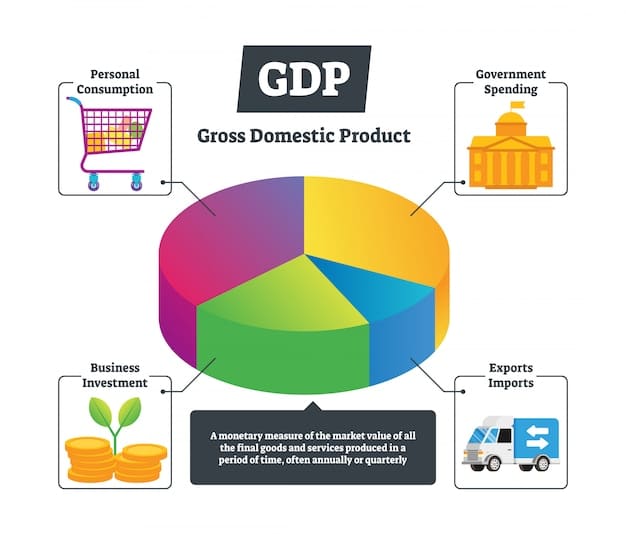ETFs for Beginners: Investing in 2025 – A Step-by-Step Guide

ETFs for Beginners: A Step-by-Step Guide to Investing in Exchange-Traded Funds in 2025 provides a comprehensive overview of ETFs, covering their benefits, risks, and how to choose the right ones to build a diversified investment portfolio for long-term financial goals.
Are you ready to dive into the world of investing? **ETFs for Beginners: A Step-by-Step Guide to Investing in Exchange-Traded Funds in 2025** is your roadmap to understanding and profiting from the exciting world of ETFs. Let’s get started!
Understanding ETFs: A Beginner’s Introduction
Exchange-Traded Funds (ETFs) have become increasingly popular among investors, especially beginners, due to their diversification, low costs, and ease of trading. Understanding what ETFs are and how they work is the first step to building a successful investment portfolio.
This section will break down the basics of ETFs, their benefits, and why they might be a great choice for beginners venturing into the world of investing.
What Exactly is an ETF?
An ETF is essentially a basket of securities that tracks an index, sector, commodity, or other assets. Unlike individual stocks, which represent ownership in a single company, ETFs provide instant diversification. When you buy shares of an ETF, you are buying a small piece of all the underlying assets within that fund.
Why Choose ETFs?
ETFs offer several advantages:
- Diversification: ETFs allow you to spread your investment across multiple assets, reducing the risk associated with investing in individual stocks or bonds.
- Low Costs: Many ETFs have low expense ratios, meaning the annual fees charged to manage the fund are minimal.
- Liquidity: ETFs are traded on stock exchanges like individual stocks, making them highly liquid, and easy to buy or sell throughout the trading day.
- Transparency: ETFs disclose their holdings daily, so you always know what you’re investing in.
Understanding these fundamentals is crucial for making informed decisions and leveraging the potential of ETFs in your investment strategy.

Step-by-Step Guide to Investing in ETFs
Now that you understand what ETFs are, let’s walk through the step-by-step process of investing in them. This section will cover everything from opening a brokerage account to placing your first ETF trade.
Following these steps ensures you start your investment journey on a solid foundation.
Step 1: Open a Brokerage Account
To buy and sell ETFs, you’ll need a brokerage account. There are many online brokers to choose from, each offering different features, fees, and investment options. Some popular choices include:
- Fidelity: Known for its research tools and commission-free trading.
- Charles Schwab: Offers a wide range of investment products and excellent customer service.
- Vanguard: Renowned for its low-cost index funds and ETFs.
- Robinhood: A user-friendly platform popular among beginners for its simplicity and commission-free trading.
Step 2: Fund Your Account
Once your account is open, you’ll need to transfer funds into it. Most brokers allow you to link your bank account for easy transfers. You can typically transfer money via ACH (Automated Clearing House), wire transfer, or even by mailing a check. Decide how much you want to invest initially and transfer that amount into your brokerage account.
Step 3: Research and Select ETFs
Before buying ETFs, it’s essential to do your homework. Consider your investment goals, risk tolerance, and time horizon. Research different ETFs that align with your strategy. Look at their expense ratios, historical performance, and underlying holdings. Websites like ETF.com and Morningstar can provide valuable information and ratings.
Step 4: Place Your Trade
Once you’ve chosen an ETF, it’s time to place your trade. Log in to your brokerage account and navigate to the trading screen. Enter the ETF’s ticker symbol (e.g., SPY for the S&P 500 ETF), the number of shares you want to buy, and the type of order you want to place (market order or limit order). Review your order carefully and submit it.
By following these steps, beginners can confidently start investing in ETFs and building a diversified investment portfolio.
Choosing the Right ETFs for Your Portfolio
Selecting the right ETFs is crucial for achieving your investment goals. With a wide array of ETFs available, it’s essential to understand your options and how they fit into your overall portfolio.
This section will guide you through the factors to consider when choosing ETFs, helping you make informed decisions that align with your investment strategy.
Understand Your Investment Goals
What are you hoping to achieve with your investments? Are you saving for retirement, a down payment on a house, or another long-term goal? Knowing your goals helps you determine the appropriate asset allocation and the types of ETFs to include in your portfolio.
Assess Your Risk Tolerance
How comfortable are you with the possibility of losing money? Your risk tolerance should influence the types of ETFs you choose. If you are risk-averse, you might prefer conservative ETFs that invest in bonds or dividend-paying stocks. If you are comfortable with more risk, you might consider ETFs that invest in growth stocks or emerging markets.
Consider Different ETF Categories
ETFs come in various forms, each with its unique investment focus:
- Index ETFs: Track a specific market index, like the S&P 500 or the Nasdaq 100.
- Sector ETFs: Focus on specific industries, such as technology, healthcare, or energy.
- Bond ETFs: Invest in fixed-income securities like government bonds, corporate bonds, or municipal bonds.
- Commodity ETFs: Track the prices of commodities like gold, oil, or agricultural products.
Evaluate ETF Metrics
Before investing in an ETF, review its key metrics:
- Expense Ratio: The annual fee charged to manage the fund (lower is generally better).
- Trading Volume: Higher trading volume usually indicates better liquidity.
- Tracking Error: How closely the ETF’s performance matches the underlying index.
- Holdings: The specific assets the ETF invests in (ensure they align with your investment goals).
By carefully considering these factors, you can construct an ETF portfolio that aligns with your financial goals and risk tolerance.
Diversifying Your ETF Portfolio
Diversification is a fundamental principle of investing. By spreading your investments across different asset classes, sectors, and geographic regions, you can reduce the overall risk of your portfolio.
This section will explore strategies for diversifying your ETF portfolio to create a balanced and resilient investment strategy.
Asset Allocation
Asset allocation involves dividing your portfolio among different asset classes, such as stocks, bonds, and real estate. A common approach is to allocate a percentage of your portfolio to stocks for growth and a percentage to bonds for stability. As you get closer to your investment goals, you might shift more of your portfolio to bonds to reduce risk.
Sector Diversification
Instead of investing solely in one sector, consider diversifying across multiple sectors. This can help protect your portfolio from industry-specific risks. For example, you might include ETFs that invest in technology, healthcare, consumer staples, and financials.
Geographic Diversification
Investing in ETFs that track international markets can provide geographic diversification. Consider ETFs that invest in developed markets (e.g., Europe, Japan, Australia) and emerging markets (e.g., China, India, Brazil). This can help you capture growth opportunities outside of your home country.
Rebalancing Your Portfolio
Over time, your portfolio’s asset allocation may drift away from your target allocation due to differences in performance across asset classes. Rebalancing involves selling some of the over-performing assets and buying more of the under-performing assets to restore your desired allocation.
By implementing these diversification strategies, you can build a well-rounded ETF portfolio that is positioned for long-term success.

Understanding ETF Fees and Expenses
One of the appealing aspects of ETFs is their relatively low cost compared to other investment vehicles. However, it’s important to understand the different fees and expenses associated with ETFs to assess their true cost.
This section will break down the various fees you might encounter when investing in ETFs and strategies to minimize their impact on your returns.
Expense Ratio
The expense ratio is the annual fee charged by the ETF to cover its operating expenses. It is expressed as a percentage of the fund’s assets. For example, an ETF with an expense ratio of 0.10% would charge $10 per year for every $10,000 invested. Lower expense ratios are generally preferred, as they eat less into your investment returns.
Trading Commissions
Many online brokers now offer commission-free trading of ETFs, but it’s still worth checking the commission schedule before placing a trade. Some brokers may charge a small fee per trade, especially for infrequently traded ETFs.
Bid-Ask Spread
The bid-ask spread is the difference between the highest price a buyer is willing to pay (the bid) and the lowest price a seller is willing to accept (the ask). A narrower bid-ask spread indicates greater liquidity and lower transaction costs. When buying or selling ETFs, aim for ETFs with tight bid-ask spreads to minimize the impact on your returns.
Other Potential Fees
Some ETFs may have other fees, such as redemption fees or account maintenance fees. These fees are less common but should be considered. Read the ETF’s prospectus carefully to understand all potential expenses.
Keeping fees in check can significantly enhance your long-term investment performance. Opting for low-cost ETFs and minimizing trading commissions can help you maximize your returns.
Long-Term Strategies for ETF Investing
Investing in ETFs is not just about making short-term gains; it’s about building wealth over the long term. Developing a long-term investment strategy can help you stay focused and disciplined, even during market volatility.
This section will explore strategies for long-term ETF investing, including dollar-cost averaging, buy-and-hold, and periodic portfolio reviews.
Dollar-Cost Averaging
Dollar-cost averaging involves investing a fixed amount of money at regular intervals, regardless of the market conditions. This can help reduce the risk of buying high and selling low. By consistently investing a set amount, you buy more shares when prices are low and fewer shares when prices are high, averaging out your purchase price over time.
Buy-and-Hold Strategy
The buy-and-hold strategy involves purchasing ETFs and holding them for the long term, regardless of market fluctuations. This strategy is based on the belief that the stock market will generally rise over time. It can be an effective way to build wealth, especially if you reinvest dividends and stay disciplined during market downturns.
Periodic Portfolio Reviews
While the buy-and-hold strategy suggests holding investments for the long term, it’s still important to periodically review your portfolio to ensure it aligns with your investment goals and risk tolerance. This might involve rebalancing your portfolio, adjusting your asset allocation, or making other changes as needed.
Reinvest Dividends
If your ETFs pay dividends, consider reinvesting them to buy more shares. This can help accelerate your wealth accumulation over time. Reinvesting dividends allows you to take advantage of compounding, where your investment earnings also earn returns.
By adopting these long-term strategies, you can harness the power of ETFs to build a secure financial future.
| Key Point | Brief Description |
|---|---|
| 💡 What are ETFs? | Baskets of securities tracking indexes or sectors, offering diversification. |
| 📊 Diversification | Spreading investments across assets reduces portfolio risk. |
| 💰 Expense Ratios | Annual fees charged by ETFs; lower ratios are preferable. |
| 📅 Long-Term Investing | Strategies like dollar-cost averaging for sustained growth. |
Frequently Asked Questions (FAQs)
▼
An ETF is an exchange-traded fund that holds a basket of assets like stocks or bonds, while a mutual fund is a pooled investment vehicle. ETFs trade like stocks on exchanges, offering intraday liquidity, unlike mutual funds which are priced once daily.
▼
Risks include market risk, where the value of the ETF can decline due to overall market conditions, and tracking error, which is the difference between the ETF’s performance and the performance of its underlying index.
▼
Consider your investment goals, risk tolerance, and time horizon. Look at factors like expense ratio, trading volume, and the ETF’s underlying holdings to ensure they align with your investment strategy.
▼
Dollar-cost averaging involves investing a fixed amount of money at regular intervals. For ETFs, this means buying a set dollar amount of shares each month, helping to average out your purchase price over time and reduce risk.
▼
Rebalancing frequency depends on your investment strategy and tolerance for deviation from your target asset allocation. A common approach is to rebalance annually or when asset allocations drift more than 5-10% from your target.
Conclusion
Investing in ETFs can be a smart and effective way to build a diversified investment portfolio, especially for beginners. By understanding the basics of ETFs, choosing the right ETFs for your goals, and implementing long-term investment strategies, you can set yourself up for financial success in 2025 and beyond.





